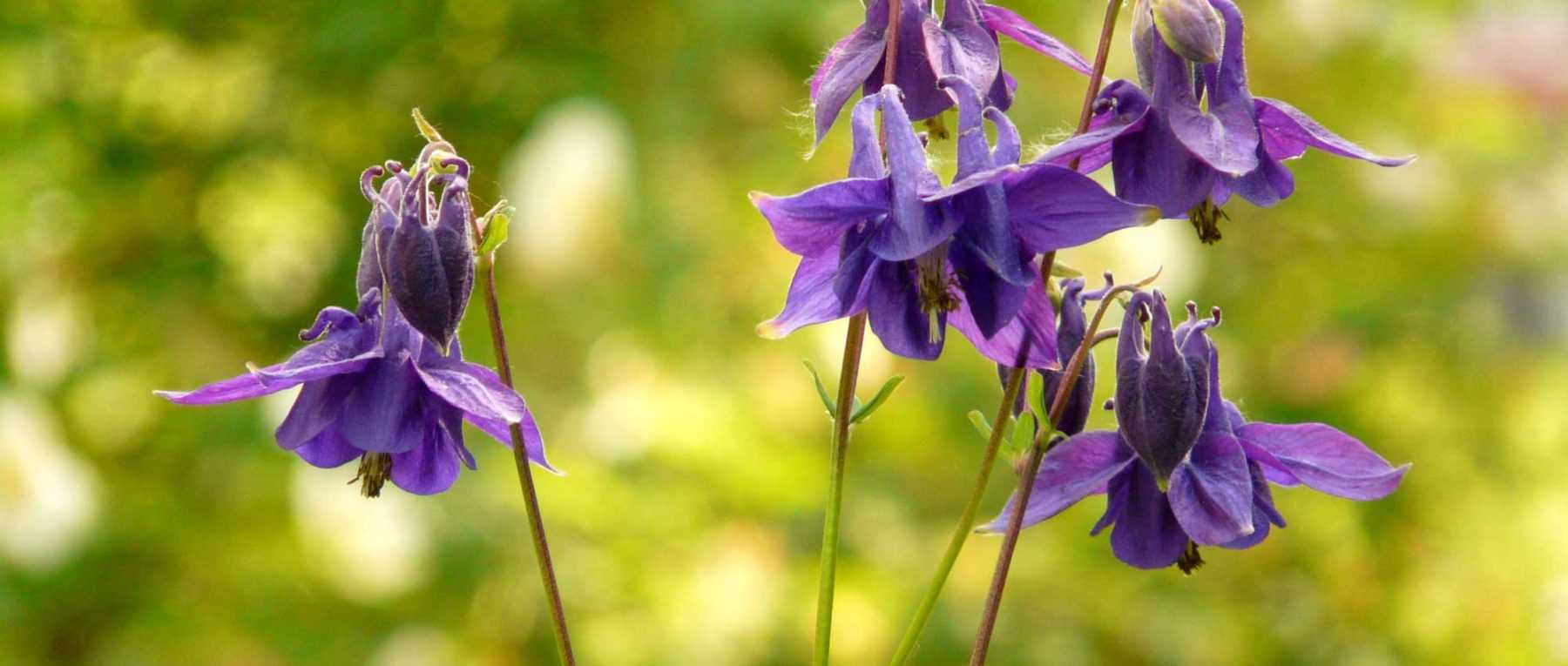
Columbines: Sowing, Planting and Care
Contents
Columbines in a Nutshell
- Columbines are easy-care perennials that produce original, delicate blooms in spring!
- They come in a wide range of colours: blue, pink, red, yellow, white, purple…
- Flowers can be single or double, plain or bicoloured
- The deeply cut foliage is highly decorative
- Being undemanding, columbines adapt to various growing conditions!
- They self-seed readily and naturalise easily
Our Expert's Word
Columbines are perennial plants that produce unique flowers in a variety of colours. Their delicate blooms are characterised by the long spurs extending from the petals. Columbines flower in spring, from May to June, sometimes extending into early summer (July-August). They feature beautiful, finely divided foliage that is light and airy. The common columbine, Aquilegia vulgaris, found growing wild in France, bears dark blue flowers, but there are numerous varieties offering a full spectrum of colours: pink, white, yellow, red, purple, violet… The flowers are often bicoloured as well. They also come in different forms: single or double blooms, sometimes resembling pompons or “grandmother’s bonnets”.
Columbines are easy to grow and relatively undemanding… making them perfect for beginners! Don’t be fooled by their delicate appearance—they are hardy, resilient plants. Planting is best done in autumn or spring, preferably in fresh, well-draining soil, though they adapt to many conditions. Alpine species thrive in rockeries. Columbines can self-seed and naturalise in the garden, but you can also collect seeds for sowing. Lastly, columbines make excellent cut flowers for bouquets!
Description and botany
Botanical data
- Latin name Aquilegia sp.
- Family Ranunculaceae
- Common name Columbine
- Flowering between May and July
- Height typically between 40 cm and one metre. Sometimes only 15-20 cm for the smallest species.
- Exposure sun or partial shade
- Soil type humus-rich, moist and well-drained
- Hardiness -20°C
Columbines are perennial plants native to temperate regions of the Northern Hemisphere. They are mainly found in Europe, North America and Asia, sometimes in mountainous areas. Some species come from Asia, such as Aquilegia flabellata. Some take their name from the mountains where they originate, like the Alpine Columbine, Aquilegia alpina, or the Pyrenean Columbine, Aquilegia pyrenaica. As for Aquilegia vulgaris, also called Granny’s Bonnet, it is found throughout mainland France. There are between 70 and 100 species of columbines, to which must be added numerous horticultural varieties. In the wild, they often grow in light woodland, on edges or in meadows.
Columbines belong to the Ranunculaceae family. A family that includes more than 2000 species of plants, mostly herbaceous, among which are buttercups, but also aconites, clematis, delphiniums or hellebores.
There are several possible etymologies for the origin of the name columbine, Aquilegia. One is that this word comes from the Latin Aquila = eagle, because the spurs extending from the petals resemble an eagle’s talons. In French, columbine is known by various vernacular names: Colombine, Gants de Notre-Dame, Aiglantine (again the idea of the eagle)…
Columbines are completely hardy perennials, they are not afraid of the cold. However, they are short-lived plants: they often live between two and four years, sometimes five, rarely more. But they compensate for this by self-seeding abundantly! Different columbine species hybridise very easily with each other.
Columbines form clumps with erect, branched stems. Most columbines grow between 40 cm and one metre tall. In any case, they rarely exceed one metre in height. Some are much smaller, like Aquilegia flabellata, which grows between ten and thirty centimetres tall. Similarly, Aquilegia saximontana does not exceed 15 cm.
Columbines usually flower from late spring to early summer, between May and July. Their flowers are borne on the ends of slender stems. They are often between three and five centimetres long. Those of the Canadian columbine are particularly small (between 1 and 2 cm long), while the largest flowers are those of the McKana hybrids, measuring up to 10 centimetres long! Depending on the variety, columbine flowers may nod towards the ground or face upwards. They may be solitary or clustered in racemes often comprising between five and fifteen flowers, sometimes up to twenty.
The flowers may be single-coloured, but are often bicoloured, usually a bright colour on the outside and white in the centre. In any case, the flowers offer a very wide range of colours: they can be white, red, orange, pink, yellow, light or dark blue, burgundy, purple, crimson… sometimes they are even almost black, as in the variety ‘Black Barlow’! As for the Aquilegia viridiflora, it has a surprising chocolate and green hue.
Columbines offer an original flowering. The flowers have five truncated petals, extended into long spurs at the back of the flower. These spurs contain nectar, appreciated by insects that come to feed on it while ensuring pollination. The tip of the spur is sometimes curved, ending in a hook. The flowers of the species Aquilegia longissima are impressive for the length of their spur, making them particularly graceful! The petals are surrounded by five coloured and well-developed sepals, resembling petals (also called tepals). It often happens that the petals are white and the sepals are a bright or dark shade (red, blue, yellow, black…). The flowers then offer a superb contrast! At the centre of the flower, there are numerous yellow stamens.
Generally, the flowers are single, composed of a row of sepals surrounding a row of petals, extended by long spurs. However, hybridisation has given rise to numerous varieties, sometimes with very different forms. There are thus double-flowered varieties! They lose their very characteristic shape, resembling more clematis flowers. There are even Aquilegia clematiflora, whose name means “clematis-flowered”. Similarly, Barlow columbines (for example, ‘Nora Barlow’ or ‘Black Barlow’) offer double pompon flowers. Sometimes, columbines have the shape of “Granny’s Bonnets”, with flowers nodding towards the ground and forming like a petticoat, with layers of overlapping petals.


Columbine flowers can take different forms: from left to right, the varieties ‘Yellow Queen’, ‘Winky Blue White’ (photo FD Richards), ‘Crimson Star’ and ‘Black Barlow’
Columbines have beautiful, deeply cut foliage. The leaves are borne on a long petiole from the base, and are divided into three segments. Each is then subdivided into three leaflets, with rounded, toothed or lobed shapes. Like the whole plant, columbine foliage has a very fine and light appearance! The few cauline leaves (= placed on the stem) are alternate. The leaves have soft, delicate shapes.
The leaves are green with a more or less bluish tinge. Those of the Common columbine (Aquilegia vulgaris), are glaucous and pubescent on the underside. There are also variegated varieties, such as ‘Leprechaun Gold’, with green leaves mottled with yellow.
Columbine is a deciduous plant. The foliage dries up in summer, once the plant has produced seeds, and reappears only in spring.
Columbine has a long taproot, quite fragile, which makes transplanting delicate.
The fruits of columbine consist of five elongated and pointed follicles. These are dry fruits that open at maturity to release numerous oval, black seeds. Don’t hesitate to collect the seeds for later sowing!
Botanical species
This is the Granny’s Bonnet, the most common species. It bears dark blue flowers, with a short, curved spur. It is found wild in France.
The Alpine Columbine has blue-violet flowers, facing downwards. It resembles the Granny’s Bonnet, but its flowers are larger and less numerous. It is perfect for a naturalistic garden.
The Canadian Columbine offers small yellow and red flowers, nodding towards the ground and extended at the back by elongated spurs. It is found wild in Canada and the United States.
The Dark Columbine bears small dark purple flowers, with long stamens and curved spurs. In the wild it is found mainly in the Alps.
The main varieties of columbines
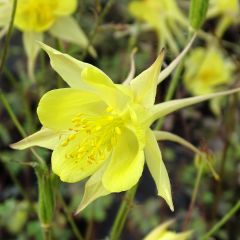
Aquilegia chrysantha Yellow Queen - Columbine
- Flowering time June, July
- Height at maturity 60 cm
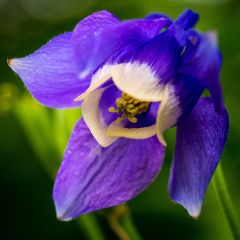
Aquilegia flabellata Ministar - Columbine
- Flowering time June, July
- Height at maturity 15 cm
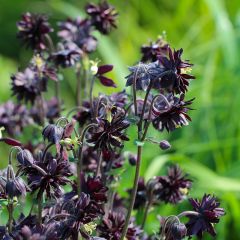
Aquilegia vulgaris var. stellata Black Barlow - Columbine
- Flowering time June to August
- Height at maturity 60 cm
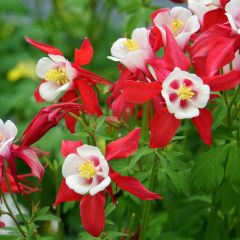
Aquilegia Crimson Star - Columbine
- Flowering time June, July
- Height at maturity 60 cm
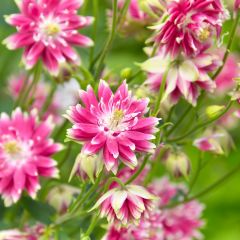
Aquilegia vulgaris Nora Barlow - Columbine
- Flowering time June to August
- Height at maturity 60 cm
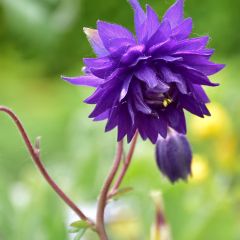
Aquilegia vulgaris Blue Barlow - Columbine
- Flowering time June to August
- Height at maturity 60 cm

Aquilegia vulgaris Munstead White - Columbine
- Flowering time June
- Height at maturity 50 cm
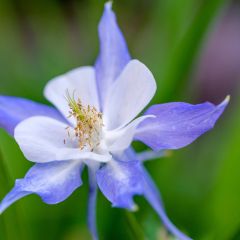
Aquilegia Blue Star - Columbine
- Flowering time May to July
- Height at maturity 60 cm
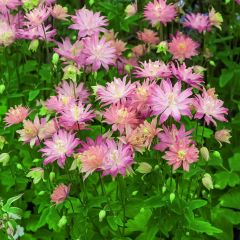
Aquilegia vulgaris Clementine Salmon Rose - Columbine
- Flowering time June, July
- Height at maturity 80 cm
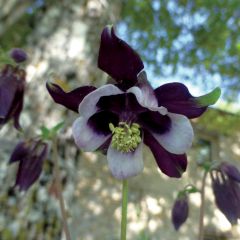
Aquilegia vulgaris William Guiness - Columbine
- Flowering time June, July
- Height at maturity 60 cm
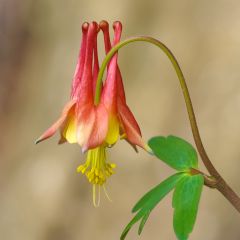
Aquilegia canadensis - Columbine
- Flowering time June, July
- Height at maturity 40 cm
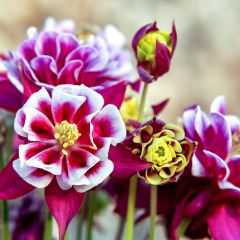
Aquilegia Winky Red-White - Columbine
- Flowering time June, July
- Height at maturity 30 cm
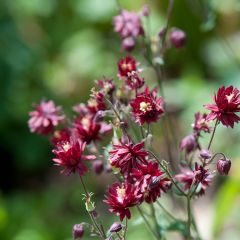
Aquilegia vulgaris Ruby Port - Columbine
- Flowering time June to August
- Height at maturity 70 cm
Discover other Aquilegia
Planting Columbines
Where to Plant?
We recommend choosing their location carefully: once established, columbines dislike being transplanted! (as they have a rather fragile taproot)
Columbines grow in sun or partial shade. You can plant them at the foot of deciduous trees or in a bright woodland area. If you live in southern France, opt for a slightly shaded spot rather than full sun.
Columbines are undemanding plants that can grow almost anywhere! However, they prefer humus-rich, light soils with plenty of organic matter. We suggest adding some compost when planting.
Plant your columbines in well-drained but moist soil. They dislike waterlogged conditions in winter but will appreciate watering during dry spells, as well as mulching to keep the soil cool. If your soil is heavy, you can plant them on a slope or add gravel to the planting hole to ensure good drainage.
As alpine species enjoy sunny spots and sandy, well-drained soils, they are perfect for rock gardens. You can grow species such as Aquilegia saximontana, Aquilegia flabellata or Aquilegia jonesii this way…
If you don’t have a garden or want to enjoy them right at home, you can also grow columbines in containers! Choose deep enough pots, add a drainage layer at the bottom, then fill with compost and plant your columbines.
When to Plant?
You can plant columbines in autumn, around September, or in spring, in March or April. We advise planting outside of frost periods.
How to Plant?
To allow your columbines to thrive, space them at least 30 centimetres apart. We also suggest grouping at least five plants of the same colour together for a more striking effect.
- Soak the root ball by placing it in a basin of water.
- If planting several columbines, arrange them on the ground first to visualise the desired effect before planting.
- Dig a planting hole, two to three times the size of the root ball.
- Add some compost or well-rotted manure to enrich the soil. For alpine species, you can also include drainage materials (pumice, gravel, etc.).
- Place the root ball in the planting hole.
- Backfill with soil and firm gently with your hands.
- Water thoroughly, then apply mulch if desired.
Also check out our video guide: How to Plant Perennials?
Maintenance
Columbines require relatively little maintenance. We nevertheless recommend watering during the summer and in case of drought. It is preferable to apply mulch around their base to keep the soil cool and to reduce the need for weeding! Use wood chips (BRF) or dead leaves. Columbines will also appreciate a well-decomposed compost application in spring.
It is generally advisable to cut back faded stems and flowers, as this encourages the appearance of new blooms. However, if you leave them in place, there’s a good chance your columbines will self-seed and naturalise. You can also collect the seeds. That said, columbines hybridise very easily, and seedlings often produce flowers different from the original varieties. If you choose to let them self-seed, you’ll likely be surprised by the emergence of flowers in different shapes and colours!
Columbines are very rarely affected by disease. They may occasionally be affected by powdery mildew, a fungal disease favoured by humidity. If you notice white, powdery spots, simply remove the affected leaves. This disease isn’t particularly troublesome, as columbines tolerate having their foliage cut back well. Columbines can also be attacked by leaf miners. These are larvae that tunnel through the thickness of the leaves, leaving white, discoloured, irregular trails. Like powdery mildew, leaf miners aren’t a serious problem—just cut off and remove the affected leaves. The columbine will produce new foliage.
Slugs and snails sometimes nibble on tender leaves. You can protect young plants by spreading ash or wood chips around them as a barrier. If this isn’t enough, consider using slug pellets.
Once flowering is over, we recommend cutting back the foliage. New leaves will emerge. Similarly, if your columbine is affected by powdery mildew or leaf miners, don’t hesitate to trim the leaves.
Propagation: sowing, division
The best technique for propagating columbines is by sowing seeds. Division of clumps is also possible, though slightly more delicate.
Sowing Columbines
Columbine seeds are best sown in spring. We recommend chilling the seeds in the refrigerator for a few weeks beforehand, as they require a cold period to germinate (vernalisation).
You can either sow seeds collected from your own plants or purchase them directly. Explore our range!
Sow directly in the ground or in pots placed under a cold frame.
- For direct sowing, prepare the soil by loosening it and adding compost. Alternatively, fill pots with potting mix and firm lightly.
- Sow the seeds and cover with a thin layer of sieved substrate.
- Press down gently.
- Water lightly with a fine spray.
- Transplant seedlings once they’re large enough to handle.
If sowing alpine species, be patient—germination can take up to two years!
Columbines also self-seed readily… They hybridise easily, often producing offspring with flowers differing from their parents. You can transplant these volunteers elsewhere in your garden.
Dividing Clumps
Columbines can be propagated by division. This method is trickier than sowing, as columbines have deep, fragile taproots, but it ensures identical plants to the parent variety. Divide in autumn.
Select a mature clump ready for division. Carefully dig deep to separate an offset from the main plant, taking care not to damage the roots. Prepare the planting site by digging a hole and adding well-rotted compost. Replant, backfill, firm the soil, and water thoroughly.
Association
You can combine columbines with other perennials to create a colourful flower bed! Plant them alongside Bleeding Hearts, Delphiniums, Catmints, or hardy geraniums. Don’t hesitate to add some spring bulbs too! Certain columbine varieties, particularly double-flowered ones like ‘Winky Double Red White’ or ‘Ruby Port’, will find their place in a romantic border, alongside roses and clematis!
Because they have a very delicate appearance, with nodding flowers at the end of long flowering stems, columbines integrate easily into naturalistic gardens. Opt for varieties with simple, small flowers. The species type, Aquilegia vulgaris, is perfect for this purpose. Plant them with grasses, alliums, masterworts… And to enhance this very natural look, allow columbines to self-seed freely in your garden! Columbines are modest perennials that don’t smother other plants; when they self-seed spontaneously, they often settle in unoccupied spaces.
You can incorporate columbines into a woodland garden, planting them alongside ferns, hostas, Bleeding Hearts… Also take advantage of the upright, soft green flower spikes of Tellima grandiflora, a perennial with decorative evergreen foliage that makes an excellent shade ground cover!
Columbines offer a wonderful diversity of blooms – take advantage of this to play with colours and create special effects! For example, compose a blue – mauve – white scene by integrating some columbines alongside delphiniums, clematis, catmints, roses… You could pair the pure white of ‘Munstead White’ columbine with Amsonia tabernaemontana, a perennial that offers star-shaped blue flowers. Conversely, you could also create a warm-toned scene by combining ‘Ruby Port’ columbine with ‘Bronze’ fennel.
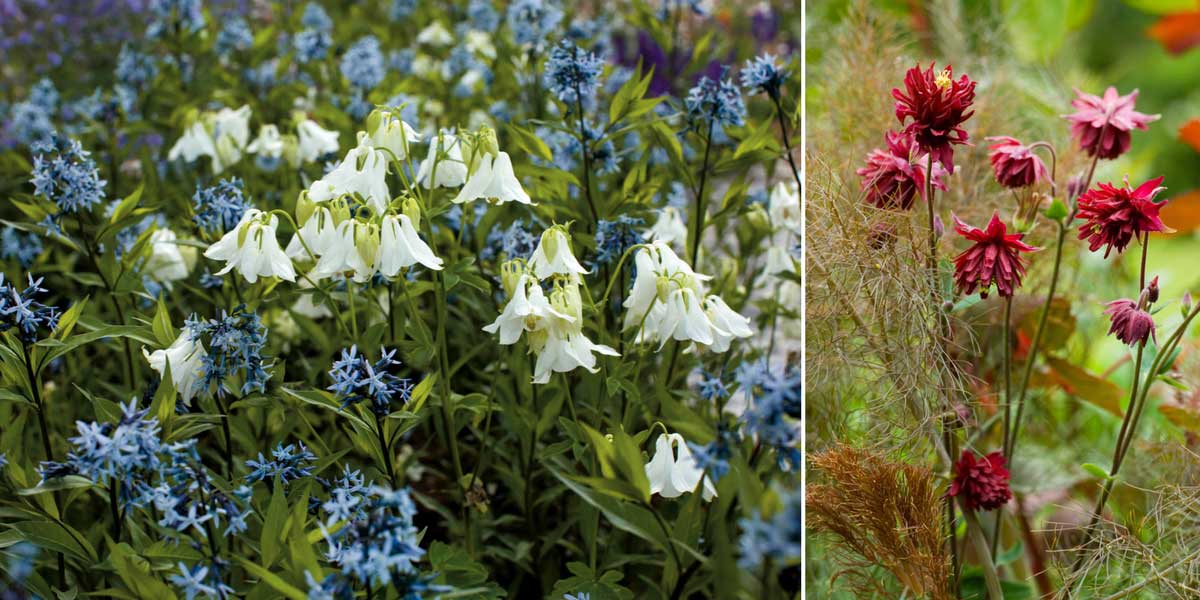

Aquilegia vulgaris ‘Munstead White’ and Amsonia tabernaemontana var. salicifolia (GAP Photos – Pernilla Bergdahl) / Aquilegia ‘Ruby Port’ and ‘Bronze’ Fennel (Photo Jonathan Buckley – Flora Press – Biosphoto)
Finally, alpine species are well-suited to rock gardens. Pair them with other plants that enjoy sunny, well-drained sites: Stipa tenuissima, aubrietas, phlox, pinks…
→ More columbine combination ideas in our advice sheet
Did you know?
- A medicinal plant
The common columbine (Aquilegia vulgaris) has medicinal properties. The root is used externally. It has soothing, antiseptic and diuretic properties, helping to relieve coughs and cleanse wounds.
Columbine can also be used as a dye plant (for colouring fabrics).
- Popular beliefs
In the Middle Ages, columbine was believed to have magical and aphrodisiac properties. Its seeds were used to make a perfume thought to render women irresistible. This belief earned the plant its common name of Bonne Femme.
Useful resources
- Discover our range of aquilegias!
- For sowing: our aquilegia seeds!
- Our video advice: How to plant perennials?
- Advice sheet: 5 frost-proof perennials
- Advice sheet: Choosing an aquilegia
Frequently asked questions
-
The leaves of my columbines have irregular white markings. What should I do?
This is the columbine leafminer: a larva that tunnels through the thickness of the leaves. If you notice its presence, don't panic... simply cut back the leaves after flowering. Columbines tolerate having their foliage cut back very well. New, healthy leaves will appear.
-
The foliage of my columbines appears nibbled
These are snails and slugs, which are fond of the leaves of young columbine plants, especially when the foliage is still tender. You can place wood chips around your plants as a barrier. If this isn't enough, use slug pellets.
- Subscribe!
- Contents




































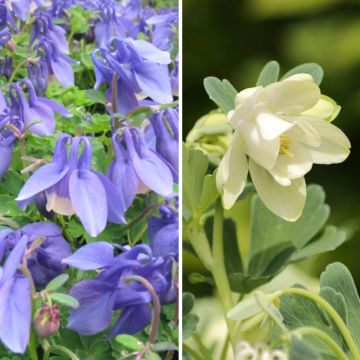




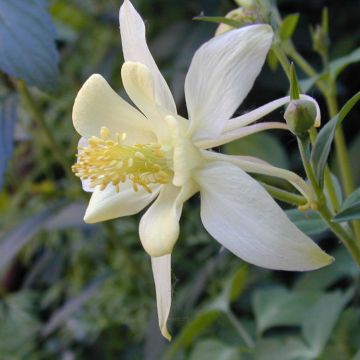
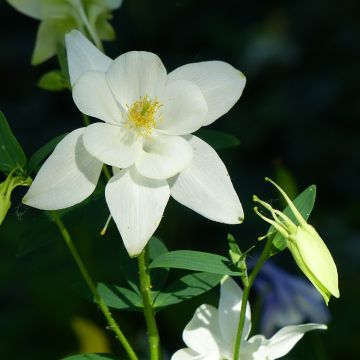


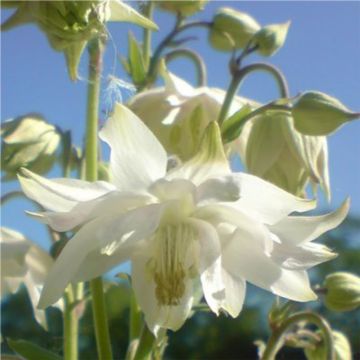





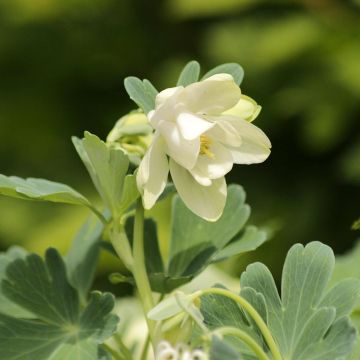

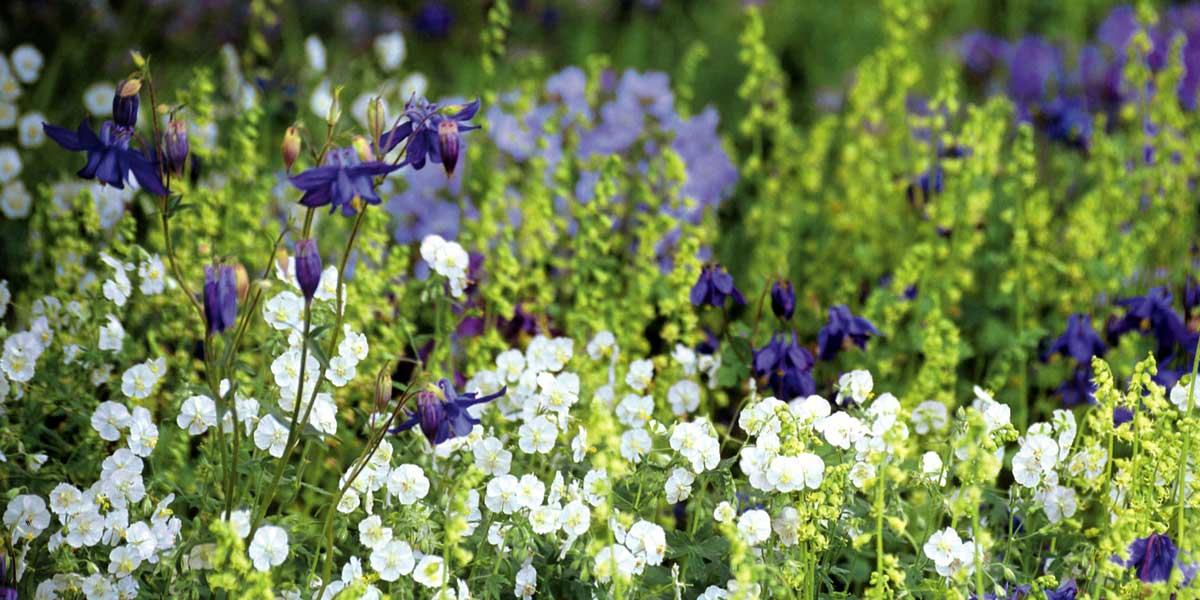
Comments